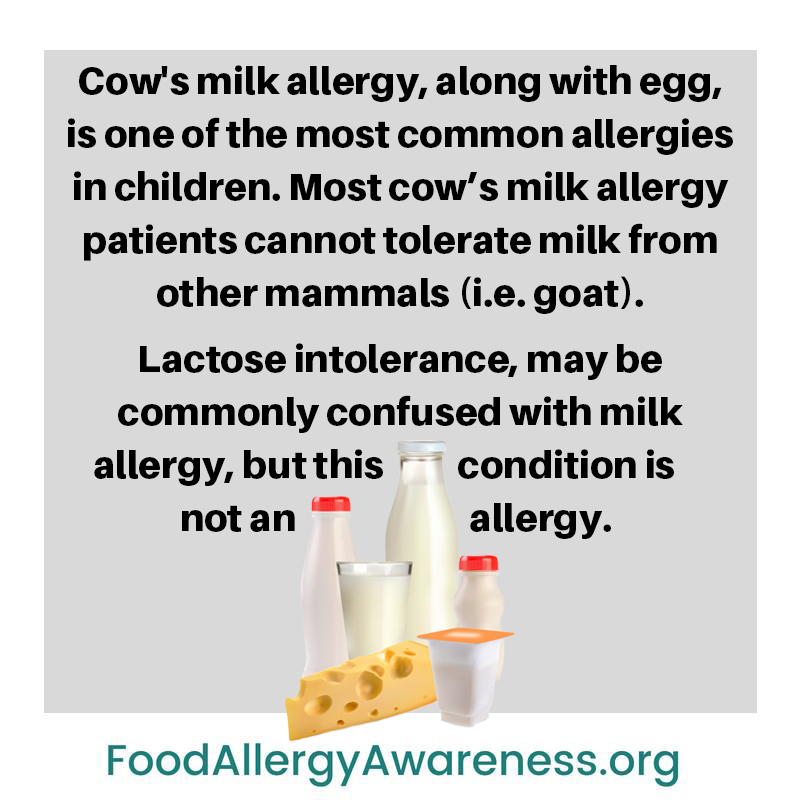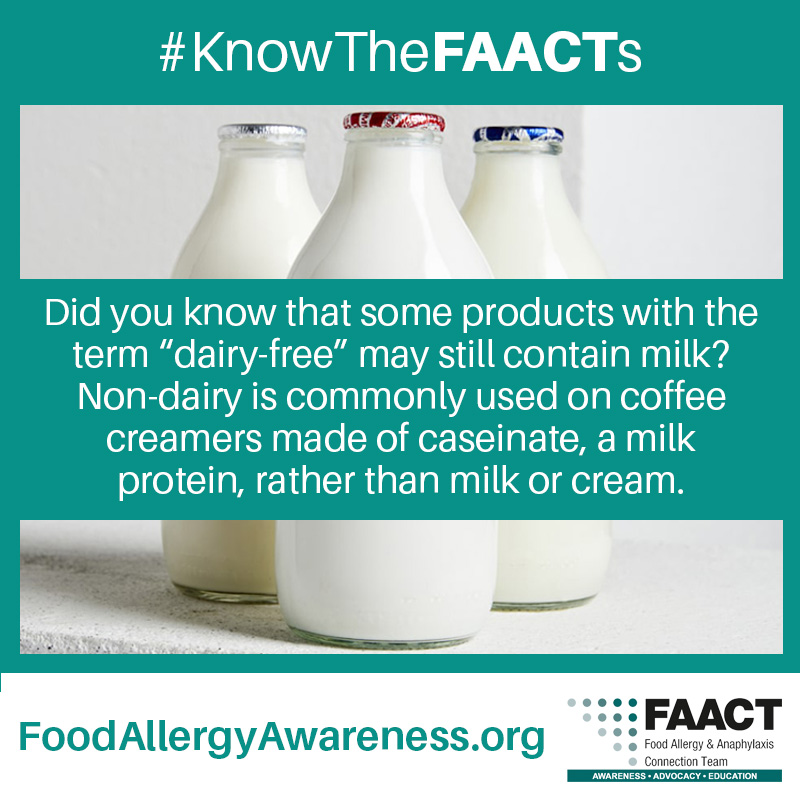Food Allergy & Anaphylaxis

Milk Allergy
Cow's milk allergy, along with egg, is one of the most common allergies in children. It is an IgE antibody-mediated reaction to proteins in cow’s milk. It was once thought that infants and children will outgrow their milk allergy prior to elementary school age. However, some milk (and egg) allergic infants and children keep these allergies well into the school years and beyond according to one large study. Studies have shown about 75% of individuals may tolerate small amounts of cow’s milk protein in extensively heated milk, such as in baked goods.
Most cow’s milk allergy patients cannot tolerate milk from other mammals (i.e. goat). Approximately 90% of cow’s milk allergic patients will react to goat and/or sheep’s milk. Many milk allergic infants will tolerate soy formula, but soy is a major allergen with an independent rate of allergy, and some doctors elect to try a different type of formula. Infants with cow’s milk allergy may tolerate extensively hydrolyzed formulas containing minimal residual amounts of milk. A substitution with an elemental formula is the most conservative management, and may be your doctor’s recommendation. Because of the different needs of each milk allergic child, please seek the assistance of a board certified allergist to find the correct formula that will assist with the milk allergic child’s developmental stage.
To confirm milk allergy, an Oral Food Challenge (OFC) can be performed in a clinical setting with a board certified allergist. OFC’s are also used to confirm when milk allergy is outgrown. Please consult with a board certified allergist for further instructions on cow’s milk in baked goods OFC, as risks may be involved, or whether the allergic individual should continue to avoid milk.
Lactose intolerance, may be commonly confused with milk allergy, but this condition is not an IgE-mediated food allergy. In lactose intolerance, individuals cannot digest the sugars (lactose) in the milk because they have a deficiency of the lactase in the lining of the gut, which leads to abdominal cramps, gas or diarrhea. This is not an immunologic reaction. In milk allergy, patients can experience cramping or diarrhea similar to lactose intolerance.
Milk can be an important source of protein, calcium, vitamin D and vitamin B12. In order to replace these dietary needs, allergic individuals may need to look at other food sources. A consultation with a pediatric nutritionist, who has experience with food allergies, may also be helpful to ensure balanced and adequate nutrition is achieved.[1]
Other Sources of Protein[6] - (it may be necessary to seek the assistance of a nutritionist to be sure the allergic individual is receiving the proper balance of amino acids).
- Meat
- Fish*
- Egg*
- Soy*
- Beans*
- Legume*
- Grains* (such as wheat germ)
Other Sources of Calcium[3]:
- Leafy Green Vegetables
- Broccoli
- Collards
- Kale
- Mustard Greens
- Turnip Greens
- Bok Choy or Chinese Cabbage
- Almonds*
- Brazil Nuts*
- Sunflower Seeds*
- Tahini*
- Dried Beans*
- Fortified juices (read labels)
Other Sources of Vitamin D[4]:
- Fatty Fish* (tuna, salmon, mackerel)
- Oysters*
- Supplements* (be aware that some supplements contain milk)
Other Sources of Vitamin B12[5]:
- Eggs*
- Fortified Foods
- Meat
- Organ Meats (liver and kidney)
- Poultry
- Shellfish*
*Be aware these are the most common allergenic foods. However, almost any food can cause an allergic reaction. It is recommended to speak with a board certified allergist before adding any new foods to the allergic individual’s diet.
Practical Tips
It is recommended to always carry at least two (2) epinephrine auto-injectors at all times if you have been diagnosed with a milk allergy. This is in case one misfires or if anaphylaxis is aggressive and a second dose is warranted. If an epinephrine auto-injector has been used, seek emergency medical assistance immediately. Strict avoidance of milk and products containing milk is necessary.
Read all product labels prior to the consumption of a new food product. According to the Food Allergen Labeling and Consumer Protection Act (FALCPA), food products with the advisory statements such as “may contain” or “manufactured in facility that process” on a package are voluntary. These statements are one in the same and manufacturers are not required to include these advisory statements. Whether or not the statement appears on a product has no baring on the safety. The absence of the statement does not necessarily mean that products may have not been exposed to cross contact. Cross-contact is when a food item has been manufactured on a shared equipment with an allergen, for example milk, during the manufacturing process. Contacting the manufacturer to confirm safety of a product is recommended.
Other ways of cross-contact (sometimes referred to as cross contamination) occurs when utensils between a safe food has been shared with an unsafe food. For example, shared cooking utensils or products, like using the same spoon in a sugar container that was used to stir a cup of coffee that had creamer in it. The sugar container is now contaminated and no longer safe for the milk allergic individual. A new container of sugar should be opened and a new spoon should be used. Cooking utensils should be thoroughly washed with soap and water.
AVOID foods that contain milk ingredients, such as:
- Artificial butter flavor, butter fat, butter oil
- Butter
- Casein and caseinates (in all forms)
- Cheese (all types)
- Cream
- Curds
- Custard
- Ghee
- Hydrolysates (casein, milk protein, protein, whey, whey protein)
- Ice Cream
- Lactalbumin, lactalbumin phosphate, lactoglobulin, lactoferrin, lactulose
- Milk
- Nougat
- Pudding
- Rennet, rennet casein
- Recaldent (TM) (used in teeth-whitening chewing gums)
- Simpless (R)
- Whey (in all forms)
- Yogurt
Milk in Unexpected Places*[2]
- Margarines
- Breads
- Cookies
- Cakes
- Chewing Gum
- Chocolates
- Cold Cuts
- Crackers
- Cereal
- Non-dairy Products
- Processed and Canned Meats
- Frozen and Refrigerated Soy Products
- Sheep Milk
- Goat’s Milk
- Deli Meats (due to cross contact from slicing cheese and meats on the same machine)
- Kosher Dairy (“D” next to the circled “K” or “U” indicates the presence of milk protein and must be avoided.)
- Kosher (Parve or pareve indicates foods not suppose to contain milk. However, foods may be considered “pareve” even if it contained a small amount of milk protein. For some this can be potentially risky, enough to cause an allergic reaction, and must be avoided.)
- Cosmetics
- Nutritional Supplements
- Medicines
- Pet Foods
Other pages that may be of interest:
Visit FAACT's CROSS-CONTACT page to review how to properly clean allergens from hands and surfaces.

FAACT
Did you know that some products with the term “dairy-free” may still contain milk? The labeling of “dairy-free” have no regulatory definition by the FDA and therefore it is necessary to read ingredient labels to check for allergens. The term “non-dairy” has a regulatory definition. However, it DOES allow presence of milk protein, casein in products. Non-dairy is commonly used on coffee creamers made of caseinate, a milk protein, rather than milk or cream. If a milk allergic individual is unsure of a product, call the manufacturer to confirm safety prior to consumption.[1]
References
[1] FAARP http://farrp.unl.edu/resources/gi-fas/opinion-and-summaries/dairy-free-and-non-dairy
[2] Consortium of Food Allergy Research (CoFAR) https://web.emmes.com/study/cofar/MILK%20AVOIDANCE.pdf
[3] NLM/NIH MedlinePlus http://www.nlm.nih.gov/medlineplus/ency/article/002412.htm
[4] NLM/NIH MedlinePlus http://www.nlm.nih.gov/medlineplus/ency/article/002405.htm
[5] NLM/NIH MedlinePlus http://www.nlm.nih.gov/medlineplus/ency/article/002403.htm
[6] NLM/NIH MedlinePlus http://www.nlm.nih.gov/medlineplus/ency/article/002467.htm
NIH: https://www.ncbi.nlm.nih.gov/pubmed/23622009 (Warren CM1, Jhaveri S, Warrier MR, Smith B, Gupta RS)